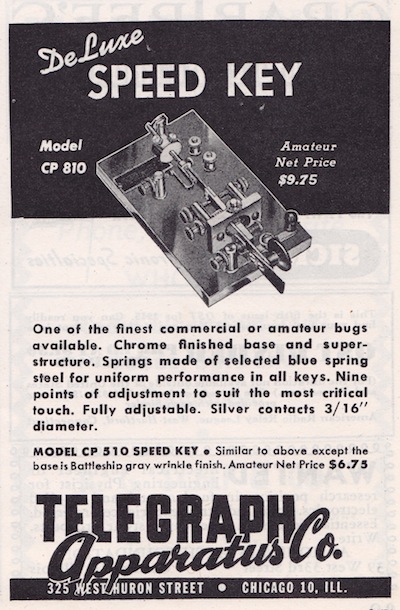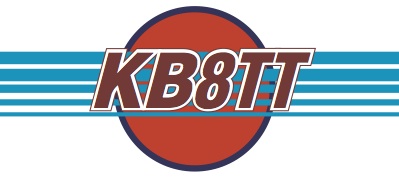

I found this key while browsing at an antique mall in my area. I was heading for a vendor that I usually visit and who normally has some radio gear. Then, out of the corner of my eye I caught the sparkle of chrome. There, sitting on a pile of old silverware, was the most unusual looking bug that I had ever seen--the base of the key was massive and the chrome was in near pristine condition. I looked at the price tag and told my XYL that this key was going home with us!
I was not familiar with the name, Telegraph Apparatus Company, and the thumb paddle and one of the horizontal posts on the frame were loose. Within minutes I had the loose components tightened up and was able to determine that there were no stripped threads and the key was in very good operating condition. A new chrome Vibroblex would cost more than three times what this key was marked at.
When I got it home, I Googled Telegraph Apparatus Company, and quickly found a bunch of links that told me that this was the famous "hole-in-the-wall" bug made by Ted McElroy. Telegraph Apparatus Company (TAC) was a partnership of McElroy and a couple of his friends. The company made bugs for sale to the public in 1944-46 while his original McElroy Company made bugs for the military in WWII. According to the information that I found, the key was not that rare. One collector said that it was a "good sender" after he did some tinkering. In general, most collectors didn't think it was worth a lot, and no one gave it "glowing" reports--it was just another bug.
I set it up on the operating desk and connected it in line with my other keys. Disappointment--this was a ham-fisted key. The dit tension (coil) spring was way too strong for comfortable sending. How could the world champion telegrapher manufacture a key that was this difficult to send with? I guessed maybe that it was because of part shortages during the war, or the key was not designed by McElroy and he simply manufactured it. Thinking about it for a while, I decided that I wanted a key that operated as good as it looked. I didn't want a showcase item. So, holding my breath, I took my side cutters and clipped off the small pigtail at the end of the spring, and then gradually nipped off bits of the spring until I got a reasonable tension. Although this sacrificed adjustability (spring ID larger than adjustment screw), it did get the tension within tolerable operating range. I would have to use a washer or something like it in order to regain the adjustablity of dit tension. After a couple of days tinkering around and searching, I found that the tab end of a picture frame hanger would work very well for my needs. I clipped the tab off and placed it over the spring adjustment screw. It fit exactly over the small end of the screw but not over the threads. Perfect! It allowed me to now adjust the spring to more tension if desired.
With the problems solved, I have been able to adjust this bug to very QRQ operation with just a small swing of the vibrating arm and close spacing of contacts. So, is this the world's fastest bug? I don't know--it is certainly much faster than any of my other bugs.
After some further research, I found that most of the references recommend the same spacings that I use on my bugs, The references also say that the hand should rest on the operating desk while you use a rolling wrist motion to operate the key. I found one reference, though, that said McElroy preferred that the hand and elbow should be raised above the desk so that the operator can use a free swinging arm motion! This explains the mystery of the strong dit tension spring. McElroy intended that the operator use a large free motion of the arm when sending. The old professsional CW operators also recommend a wide swing of the wrist, but don't use the wide unsuppoted arm swing of McElroy.
I personally don't think that I could use such a wide motion in my sending. I am most comfortable with my wrist rolling back and forth, my hand supported on the operating desk by my small finger, which acts as a pivot point. Here is a short video of the bug. The speed of the bug was just a bit too fast for me and I would probably be more comfortable by adding the third weight to the key: https://youtu.be/huYY-3ewGQ4


Under side of TAC Hole-In-The-Wall Bug
Note: McElroy hated his name "Ted," and much preferred T.R. I decided to use his first name because most hams are more familiar with that than his initials.
